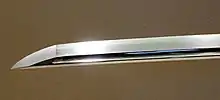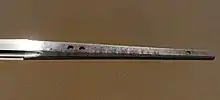刀 (日本刀)
历史
日本煅刀历史可大概划分为以下几个节点:[4]
- 上古刀(约到公元900年前后)
- 古刀 (公元900年 - 1596年)
- 新刀(1596年 - 1780年)
- 新新刀 (1781年 - 1876年)
- 现代刀(1876年 - 1945年)[5]
- 新作刀(1953年 - )[6]
史料记载中,人们第一次使用“刀”(那时为gatana)来描述一种与太刀不同的长刀是早在鎌倉時代(1185年 - 1333年)期间。[7]这些当时被称为“打刀”(uchigatana)和“tsubagatana”的刀似乎是在指代一种不同的刀,可能是一种给低阶士兵使用的廉价刀。元日战争进一步改进了日本刀的设计。在战争中,日本士兵发现自己手头上薄薄的太刀和直刀无法刺破蒙古士兵煮制的皮甲,刀身也时常碎裂甚至整个断掉。[8]由太刀向刀的转化大约是在室町时代进行的。大约在1400年前后,人们开始制造那些铭文有“Katana”的长刀。这一点是为了和佩戴太刀的侍相呼应——一般来说,在随身携带日本刀时,都会将铭朝下佩戴。太刀如果按照刀的佩戴方法佩戴,那么刀刃就会朝上了。刀匠在相反方向刻铭,可能暗示着那时的一些侍用了不同的佩刀方法。[9][10]

江户时代的一把刀的刀刃

江户时代的刀莖
参考资料
- Manouchehr Moshtagh Khorasani. . Peter Lang. 2008: 150 [2017-05-27]. ISBN 978-3-03911-711-6. (原始内容存档于2019-01-07).
- Evans Lansing Smith; Nathan Robert Brown. . Alpha Books. 2008: 144 [2017-05-27]. ISBN 978-1-59257-764-4. (原始内容存档于2019-01-07).
- Kokan Nagayama; trans. Kenji Mishina. . Tokyo, Japan: Kodansha International Ltd. 1997. ISBN 4-7700-2071-6.
- . news.qq.com. [2017-10-02]. (原始内容存档于2017-10-03) (中文(中国大陆)).
- Clive Sinclaire. . Lyons Press. 1 November 2004: 40–58 [2017-10-02]. ISBN 978-1-59228-720-8. (原始内容存档于2016-05-14).
- トム岸田. . Kodansha International. 24 September 2004: 42 [2017-10-02]. ISBN 978-4-7700-2754-2. (原始内容存档于2020-10-22).
- Kanzan Sato. . Japan: Kodansha International. 1983: 220. ISBN 978-0-87011-562-2.
- Satō, Kanzan. Kodansha International. 1983. Page 104
- Stephen Turnbull. . Osprey Publishing. 8 February 2011: 22– [2017-10-11]. ISBN 978-1-84908-658-5. (原始内容存档于2014-07-23).
- Kōkan Nagayama. . Kodansha International. 1997: 28 [2017-10-11]. ISBN 978-4-7700-2071-0. (原始内容存档于2020-05-15).
This article is issued from Wikipedia. The text is licensed under Creative Commons - Attribution - Sharealike. Additional terms may apply for the media files.



